World History
 |
 |
 |
 |
 |
 |
 |
Catholicism in Sri Lanka
Being asked to write about my experience as a Catholic young woman in Sri Lanka, I found it to be a broad and interesting topic. For the convenience of the reader, I have divided this article into different parts that will help to give him an idea of the land in which I live.
For a quick overview, according to a national census (from 2012), the percentage of the various religions here are as follows: 70.2% Buddhist, 12.6% Hindu, 9.7% Muslim. Catholics make up only around 6% of the population and, contrary to what many people might think, do not face any official persecution.
Personally, I have not faced any discrimination for being a Catholic, and I say this as one who lives in a mostly Buddhist town.
The Mannar Martyrs & their legacy
The Portuguese officially brought the Faith to the country in the 16th century.
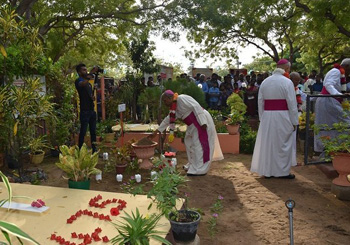 Here the Mannar Martyrs deserve mention. They were a group of Catholic converts numbering around 700 men, women and children who were massacred for the Faith in the year 1544. King Cankili I, angry that the new converts were razing temples and idols and worshiping an unknown God in their place, issued an edict to “renounce Christianity or die.”
Here the Mannar Martyrs deserve mention. They were a group of Catholic converts numbering around 700 men, women and children who were massacred for the Faith in the year 1544. King Cankili I, angry that the new converts were razing temples and idols and worshiping an unknown God in their place, issued an edict to “renounce Christianity or die.”
Between 600 to 700 of the faithful were slain with great cruelty. This heroic group of Sri Lankans were some of the first fruits of the work of St. Francis Xavier. The Portuguese missionaries, who later came to evangelize, attributed the rapid growth of Catholicism to their martyrdom and intercession.
When the Protestant Dutch took over in 1658, they made Catholicism illegal, banished priests and even incited the Kings to persecute the children of the Church. The Catholics did not renounce their faith but continued to practice it privately. Some say that there were no priests until St. Joseph Vaz came in 1687, but others affirm that priests continued their work in secret. Notwithstanding, at the end of the Dutch period, the officially prohibited Faith had gained more devotees than had the heretics.
Particular devotions
The Catholics of Sri Lanka have a tender devotion to four Saints in particular, namely, St. Anne, St. Sebastian, St. Jude Thaddeus and St. Anthony of Padua. In some households the practice of lighting an oil lamp on the first Tuesdays and Thursdays in honor of Sts. Anthony and Jude respectively is carefully kept.
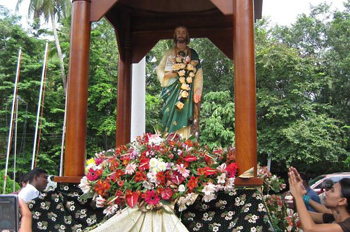 The Church of St. Jude in Indigola (located in the Western province) brings throngs of devotees to its doors on the Feast of that great Apostle. One can also always find a holy statue commemorating St. Sebastian in most churches. Even some Buddhists pray to this great Saint for the healing miracles he grants.
The Church of St. Jude in Indigola (located in the Western province) brings throngs of devotees to its doors on the Feast of that great Apostle. One can also always find a holy statue commemorating St. Sebastian in most churches. Even some Buddhists pray to this great Saint for the healing miracles he grants.
The National Shrine of St. Anne in Talawila, which has existed since 1703, is another beloved Church here. There are several origin stories of this Shrine: The best known account is of a poor Portuguese man who journeyed from Mannar to Colombo seeking a livelihood at the beginning of the 18th century. Returning back without success, he rested beneath a tree on the coast where he dreamed he saw the image of St. Anne with lit candles on each side. He arose and discovered that the image was really there. After praying aloud in this situation, he beheld the glorious Matriarch standing before him.
St. Anne told the poor man that the image he had seen represented her and that a Church should be built in that place and dedicated to her. Marveling at what he witnessed, he began to construct a small chapel. Later, St. Anne appeared to him again and gave him some gold coins which he used to sail back to his country, and there he raised the funds to erect a permanent church at Talawila. Later, he built a larger church on that same site.
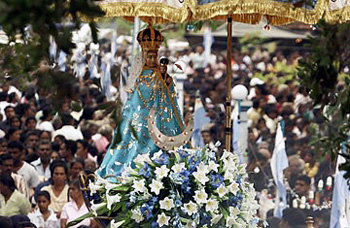 Devotion to Our Lady is very dear to the hearts of the Catholics in this country. Her images are adorned with flower garlands and she is draped with silk robe. Even those who do not believe in God will come to her shrines to implore her help for their illnesses and troubles. A grotto of Our Lady of Lourdes is usually present outside Catholic churches here.
Devotion to Our Lady is very dear to the hearts of the Catholics in this country. Her images are adorned with flower garlands and she is draped with silk robe. Even those who do not believe in God will come to her shrines to implore her help for their illnesses and troubles. A grotto of Our Lady of Lourdes is usually present outside Catholic churches here.
The Rosary is recited by many Catholics in Sri Lanka and hymns are composed and sung in the Sinhalese, Tamil and English languages.
St. Joseph Vaz
One of my country’s most popular devotions is to Fr. Joseph Vaz (1651 - 1711). Originally an Oratorian priest from Goa, he determined to go to assist the Sri Lankan Church, persecuted by the heretics. He made his way here disguised and, after his safe arrival, he administered the Sacraments to crypto-Catholics, performing many miracles and making conversions.
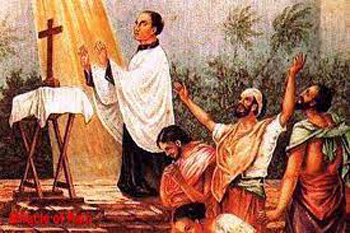 Once, there was a drought in the royal city of Kandy, which became his headquarters. After the ceremonies to procure rain had been performed by Buddhist religious to no avail, the King sent some of his courtiers to ask Fr. Vaz to pray for rain.
Once, there was a drought in the royal city of Kandy, which became his headquarters. After the ceremonies to procure rain had been performed by Buddhist religious to no avail, the King sent some of his courtiers to ask Fr. Vaz to pray for rain.
Our Saint set up an altar opposite the palace, placed a Cross on it and prayed that God would glorify His Name by sending rain. Before he could rise, rain poured abundantly from the sky but not a drop touched him. Thereafter, he was given singular privileges by the King and many conversions took place among the Kandyan people.
In 1697, on returning to Kandy from his apostolic travels, Fr. Vaz discovered that a violent outbreak of smallpox was killing many persons. The slaves and beggars who had contracted the illness were left to die in jungles and deserted areas. St. Joseph Vaz and his nephew cared for the abandoned, feeding and clothing them and administering medicines to them.
When the King and his court left the city in fear of contacting the sickness, St. Joseph Vaz remained, visiting the abandoned sick in their own homes and working marvelous deeds for them. Once again, many conversions occurred because of his selfless charity.
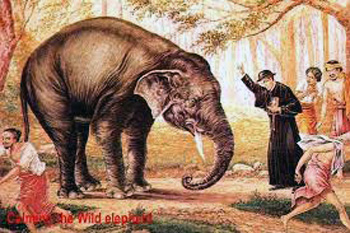 On another occasion, while passing through a bush, Fr. Joseph Vaz came across a ferocious elephant that was obstructing his way, leaving no way for escape. Fr. Joseph Vaz stopped, prayed and then instructed his companions to have full trust and confidence in God Who would not desert them. He and his companions then walked over the elephant as if it were the trunk of a tree.
On another occasion, while passing through a bush, Fr. Joseph Vaz came across a ferocious elephant that was obstructing his way, leaving no way for escape. Fr. Joseph Vaz stopped, prayed and then instructed his companions to have full trust and confidence in God Who would not desert them. He and his companions then walked over the elephant as if it were the trunk of a tree.
St. Joseph Vaz was a tireless servant of God and a Slave of Mary. He had consecrated himself to her in 1677, sealing that blessed consecration in a Deed of Bondage.
This holy priest travelled throughout my country, visiting Hanwella, Malwana, Colombo, Negombo, Puttalam, Manthota, Punarim, Kottiyarhe, Trincomalee, Batticaloa and Sammanturai. He once walked over a flooded river along with his companions and other travellers without any of them being injured.
He closed his blessed life in Kandy, on the 16th of January, 1711, being just 59 years old. He is called the Apostle of Sri Lanka.
Customs & society
As a counter-revolutionary, it is not so difficult to live in Sri Lanka as it is a strongly conservative society with many traditional aspects.
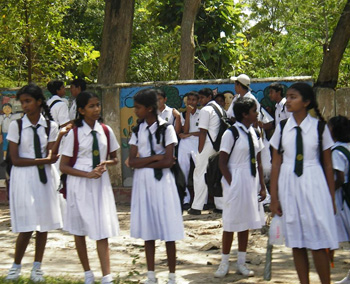 Of course, this differs from place to place, as some areas are more modernized than others. But in my region, it is very rare for a young woman to leave her parent’s house unless she is studying, working or getting married. The father is the head of the household and married women are housewives instead of seeking careers. Sadly, this is starting to change.
Of course, this differs from place to place, as some areas are more modernized than others. But in my region, it is very rare for a young woman to leave her parent’s house unless she is studying, working or getting married. The father is the head of the household and married women are housewives instead of seeking careers. Sadly, this is starting to change.
The lifestyle here is simple and the people are hard working. Teachers are greatly respected and schools are mostly very disciplined, with strictly implemented rules.
In some areas, locals still regard their social rank and place of birth with great honor and pride; great importance is placed on protecting the family name and history from any scandal whatsoever.
In conclusion, I must confess that I learned a little more about the history of the Faith in my own land while writing this account and am grateful to God for what I have learned.
While the faithful in Sri Lanka are not free from the effects of modernism, superstition and ecumenism, by the grace of God, I can safely say that this is a fertile land where I hope true Christianity – which is Catholicism - will blossom during the Reign of Mary.

For a quick overview, according to a national census (from 2012), the percentage of the various religions here are as follows: 70.2% Buddhist, 12.6% Hindu, 9.7% Muslim. Catholics make up only around 6% of the population and, contrary to what many people might think, do not face any official persecution.
Personally, I have not faced any discrimination for being a Catholic, and I say this as one who lives in a mostly Buddhist town.
The Mannar Martyrs & their legacy
The Portuguese officially brought the Faith to the country in the 16th century.

The site of the martyrdom has become a popular pilgrimage spot
Between 600 to 700 of the faithful were slain with great cruelty. This heroic group of Sri Lankans were some of the first fruits of the work of St. Francis Xavier. The Portuguese missionaries, who later came to evangelize, attributed the rapid growth of Catholicism to their martyrdom and intercession.
When the Protestant Dutch took over in 1658, they made Catholicism illegal, banished priests and even incited the Kings to persecute the children of the Church. The Catholics did not renounce their faith but continued to practice it privately. Some say that there were no priests until St. Joseph Vaz came in 1687, but others affirm that priests continued their work in secret. Notwithstanding, at the end of the Dutch period, the officially prohibited Faith had gained more devotees than had the heretics.
Particular devotions
The Catholics of Sri Lanka have a tender devotion to four Saints in particular, namely, St. Anne, St. Sebastian, St. Jude Thaddeus and St. Anthony of Padua. In some households the practice of lighting an oil lamp on the first Tuesdays and Thursdays in honor of Sts. Anthony and Jude respectively is carefully kept.

Processions at the Church of St. Jude in Indibola, above, & the National Shrine of St. Anne in Talwila, below
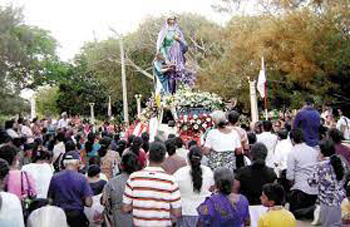
The National Shrine of St. Anne in Talawila, which has existed since 1703, is another beloved Church here. There are several origin stories of this Shrine: The best known account is of a poor Portuguese man who journeyed from Mannar to Colombo seeking a livelihood at the beginning of the 18th century. Returning back without success, he rested beneath a tree on the coast where he dreamed he saw the image of St. Anne with lit candles on each side. He arose and discovered that the image was really there. After praying aloud in this situation, he beheld the glorious Matriarch standing before him.
St. Anne told the poor man that the image he had seen represented her and that a Church should be built in that place and dedicated to her. Marveling at what he witnessed, he began to construct a small chapel. Later, St. Anne appeared to him again and gave him some gold coins which he used to sail back to his country, and there he raised the funds to erect a permanent church at Talawila. Later, he built a larger church on that same site.

A strong devotion to Our Lady among Sri Lanka Catholics
The Rosary is recited by many Catholics in Sri Lanka and hymns are composed and sung in the Sinhalese, Tamil and English languages.
St. Joseph Vaz
One of my country’s most popular devotions is to Fr. Joseph Vaz (1651 - 1711). Originally an Oratorian priest from Goa, he determined to go to assist the Sri Lankan Church, persecuted by the heretics. He made his way here disguised and, after his safe arrival, he administered the Sacraments to crypto-Catholics, performing many miracles and making conversions.

Fr. Joseph Vaz prays for rain &
God immediately hears his prayer
Our Saint set up an altar opposite the palace, placed a Cross on it and prayed that God would glorify His Name by sending rain. Before he could rise, rain poured abundantly from the sky but not a drop touched him. Thereafter, he was given singular privileges by the King and many conversions took place among the Kandyan people.
In 1697, on returning to Kandy from his apostolic travels, Fr. Vaz discovered that a violent outbreak of smallpox was killing many persons. The slaves and beggars who had contracted the illness were left to die in jungles and deserted areas. St. Joseph Vaz and his nephew cared for the abandoned, feeding and clothing them and administering medicines to them.
When the King and his court left the city in fear of contacting the sickness, St. Joseph Vaz remained, visiting the abandoned sick in their own homes and working marvelous deeds for them. Once again, many conversions occurred because of his selfless charity.

Fr. Joseph Vaz confronts a wild elephant
St. Joseph Vaz was a tireless servant of God and a Slave of Mary. He had consecrated himself to her in 1677, sealing that blessed consecration in a Deed of Bondage.
This holy priest travelled throughout my country, visiting Hanwella, Malwana, Colombo, Negombo, Puttalam, Manthota, Punarim, Kottiyarhe, Trincomalee, Batticaloa and Sammanturai. He once walked over a flooded river along with his companions and other travellers without any of them being injured.
He closed his blessed life in Kandy, on the 16th of January, 1711, being just 59 years old. He is called the Apostle of Sri Lanka.
Customs & society
As a counter-revolutionary, it is not so difficult to live in Sri Lanka as it is a strongly conservative society with many traditional aspects.

The schools are conservative & well disciplined
The lifestyle here is simple and the people are hard working. Teachers are greatly respected and schools are mostly very disciplined, with strictly implemented rules.
In some areas, locals still regard their social rank and place of birth with great honor and pride; great importance is placed on protecting the family name and history from any scandal whatsoever.
In conclusion, I must confess that I learned a little more about the history of the Faith in my own land while writing this account and am grateful to God for what I have learned.
While the faithful in Sri Lanka are not free from the effects of modernism, superstition and ecumenism, by the grace of God, I can safely say that this is a fertile land where I hope true Christianity – which is Catholicism - will blossom during the Reign of Mary.

Posted January 5, 2024
______________________
______________________





